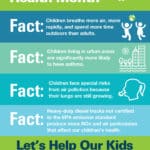October is Clean Fleet Month & Children’s Health Month
 It is somewhat ironic that Clean Fleet Month and Children’s Health Month share the month of October. Poor air quality has become a health crisis for many of our young people, particularly in urban areas. And more children live in urban areas than ever before. The #1 source of harmful urban emissions is heavy-duty trucks not certified to the latest EPA NOx emission standard.
It is somewhat ironic that Clean Fleet Month and Children’s Health Month share the month of October. Poor air quality has become a health crisis for many of our young people, particularly in urban areas. And more children live in urban areas than ever before. The #1 source of harmful urban emissions is heavy-duty trucks not certified to the latest EPA NOx emission standard.
The American Academy of Pediatrics (AAP) maintains that air pollution is associated with respiratory problems, asthma, premature births, infant mortality, and deficient lung growth. The AAP reflects this position in the policy statement, Ambient Air Pollution: Health Hazards To Children, which details the potential impacts of air pollution on the health of children. AAP goes so far as to encourage health professionals to choose public transportation, non-motorized modes of transportation or low-emissions vehicles to serve as role models and help encourage others to take steps to improve air quality in their community.
According to the American Lung Association, children face special risks from air pollution because their lungs are growing and because they are so active and breathe in a great deal of air. They are outside for longer periods than adults and are usually more active when outdoors.
The Southern California Children’s Health study looked at the long-term effects of air pollution on children and teenagers. Researchers found that those who grew up in more polluted areas face increased risk of reduced lung growth, which may never recover to the full capacity. The average drop in lung function was similar to the impact of growing up in a home with parents who smoked.*
In 2017 researchers reviewed these long-term studies of children in Southern California and the impact of improvements in air quality on their health. They concluded that the 20 years of collected data provided strong evidence of the potential to improve children’s health by reducing some of the most common outdoor air pollutants.**
The NOx emissions and air particulates delivered by aging heavy-duty diesel fleets that do not meet the EPA NOx emission standard are a prime contributor to the unsafe air that children are breathing, particularly in urban areas. Currently available heavy-duty natural gas engine technology is an immediate answer to dramatically reducing these harmful emissions. To find out how safe the air is in your community, visit www.airnow.gov for daily updates.
Let’s Help Our Kids Breathe Easy. Choose Cleaner, Healthier Natural Gas. #CleanFleetMonth
*Laurent O, Hu J, Li L, et al. A statewide nested case-control study of preterm birth and air pollution by source and composition: California, 2001-2008. Environ Health Perspect. 2016. 124:1479-1486. doi: 10.1289/ehp.1510133.
**Gilliland F, Avol E, McConnell R, Berhane K, Gauderman WJ, Lurmann FW, et al. 2017. The Effects of Policy-Driven Air Quality Improvements on Children’s Respiratory Health. Research Report 190. Boston, MA:Health Effects Institute.

